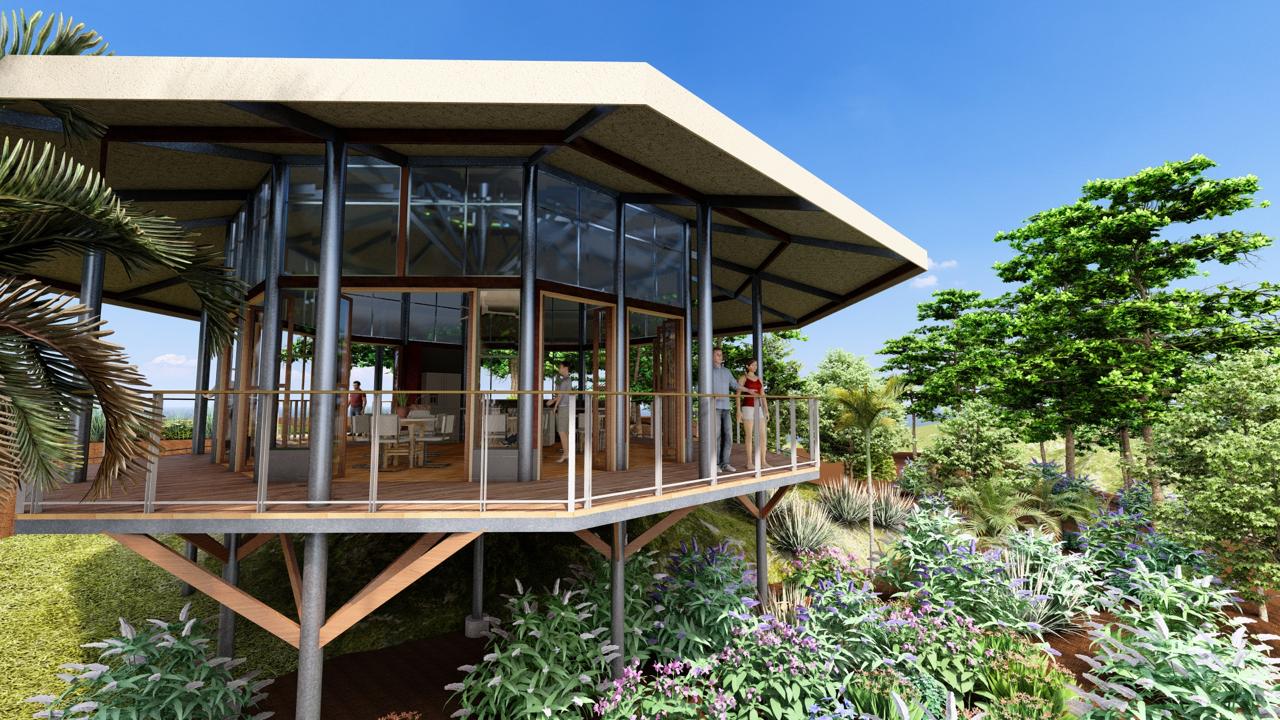Architecture for the end of the world
When I die, I want to be buried in the middle of the forest... that way, I can be reborn in tender green leaves, in fruits that from the tallest trees see the blue sea... in vines that now sneak furtively between the branches of the trees, the stones, the rivers... In springs of crystal-clear water that caress the stones and greet the multicolored birds with their cheerful laughter.I also want to be reborn in the first rains of May, which like tears of happiness, flood the bluish green fields and dusty roads with hope... Society teaches us to think in a linear way, a beginning and an end. However, life has a more quantum-like behavior. Economically we are taught to think in scarcity. "Money isn’t enough" is probably one of the most popular phrases these days.
The fear of an economic collapse keeps humanity on edge and seems to lurk like an evil shadow over everyone's peace. The media, for their part, are flooded with debates about the possible solutions and actions to be taken to save humanity from such an economic embezzlement. However, what has caused this crisis, and how does it affect the way we have been doing architecture in Costa Rica?
Probably one of the most sustainable societies was that of our grandparents. There were no credit cards, no mortgages, every purchase was made in cash, and for this, there was a prior saving time. If there was no money to buy something, people simply waited until they had it. From a construction point of view, materials that were at hand were used. Wood, stone, and clay were used daily.
The climatic solutions were simple but effective. High ceilings, lattices, windows placed strategically to ventilate and light naturally. Use of vegetation, mostly native, extracted from the nearby mountains, added not only beauty but comfort by reducing temperatures and stopping gusts of wind and dust.
Most of these materials were manually extracted, consuming very little energy during the process, and their degradation did not imply long periods of time. But what happened? A brief historical review. For many years, architecture was more of a discipline for a small group of people who had the economic capacity to pay for it. Most of the representative buildings designed and constructed during the 20th century were institutional, religious, or belonged to the wealthy class of our country.
However, during the 90s, the world set its sights on our Costa Rica, largely due to the Nobel Peace Prize. Costa Rica then became a very attractive destination for investors who were fleeing the increasingly developed and saturated Mexican beaches like Cancún and Acapulco. Costa Rica offered a politically stable environment, beautiful beaches, and friendly people. From here, a wave of development was unleashed whose main driving force was the investment of large sums of money in immense works, where waste and excess were the order of the day.
However, everyone was too busy having fun, and no one even imagined that all this waste could come to an end. Thus, the crisis took everyone by surprise. Many lost their jobs, and many businesses went bankrupt, deeply affecting the country's economy. During a crisis, two sectors that are most affected are tourism and construction. People do not travel or build since they prefer to retain capital to meet immediate needs like buying food, paying bills, or simply to have a fund in case of emergencies.
It was thus that the way architecture had been done changed, creating a crossroads, a paradigm shift, and those who were coming to invest their money now thought twice, trying to make the most of the space, avoiding waste. It is said that those who manage to adapt to change are the ones who survive, however, many are still waiting for someone to come and save us.
Strategies for change
The first step to adapt is a change in attitude. Sobriety and adequate planning when building are essential to reduce waste and, therefore, save energy and money. Sustainability in architecture does not only imply using environmentally friendly materials or natural ventilation and lighting but also includes economic sustainability, which is achieved by rationally using available resources and consequently ensuring their availability in the future. For example, some important variables when building that promote savings are:
- Thinking in smaller but adequately designed spaces is a vital factor to avoid waste.
- Evaluating the possibility of reusing materials. Some materials we consider trash could be used in our construction, reducing costs, such as pallets, containers, tires, bottles, among others.
- Simplicity. There is a saying that if it’s hard to draw, it’s hard to build. Overly complicated designs promote waste if the materials used are not thought of from the conceptualization stage. Most materials available on the market are meant to follow an orthogonal pattern, so if we get too organic, we may end up with a mountain of waste on our site. Organic is not necessarily sustainable.
- Planting: We can live without cars, without cell phones, without technology… but no one can live without food.
Allocating spaces for planting should be a mandatory variable when designing. Currently, horticulture is the
second most popular practice in the world, and even in large cities, people plant on rooftops and windowsills.
Planting vegetables, herbs, and medicinal plants will not only reduce your supermarket and pharmacy bills but
also improve the quality of the space we live in and make it more pleasant. According to a NASA study, there are
types of plants, which are easily accessible, that help purify the air in a space by eliminating toxic
components such as formaldehyde. Some of them are the mother-in-law’s tongue, the money plant, and the yellow
palm, which can be found in any bush in our country.
The first step to face a paradigm shift like the one we are living through right now is to stop and reflect. Think about how many of the things you own right now are not indispensable and that you could perfectly live without them. Changing your attitude means being aware that, right now, millions of people around the world have nowhere to live and nothing to eat. Saving and sobriety when building is not only good for ourselves, it is respect for our fragile planet, for humanity, and for those who come after us. So if the end of the world comes, don’t let it take you by surprise again... Walk more, always more, live more!
MUD ARCHITECTURE: UTOPIA OR REAL CONSTRUCTIVE ALTERNATIVE
From clay we were born and to clay we will return... Bahareque... Its mere evocation revives black and white photos, houses that seem to hide the souls of their former inhabitants. Tired facades that bend to time, trapped by vines that exhibit themselves triumphantly through canes and clay. Stories woven in silence before rough and hard wood, old newspaper clippings... images of virgins and angels that seem to watch over those who ventured into their domains. Old things... daring rays of sun that infiltrate the most hidden corners, as if they wanted to spy on what happens inside... Clay... cane... wood... Bahareque emerged in pre-Columbian times, but adobe replaced it for a time. After the Cartago earthquake, adobe was prohibited, and bahareque returned as a safe option, according to Article 2 of the Construction Regulations of that time:
Art. 2: Construction in bahareque, wood, frame, cement, brick, or metal is allowed with a license and according to the regulations of the Executive Power. A license is only required in populated areas.
Later, bahareque fell into disuse due to the boom of the 20th century, being replaced by concrete, wood, metal, and ceramics.
Remains of earth constructions with cane and wood can be found in Nicoya and San Ramón. It is known that the indigenous people dug trenches, placed vertical stakes, found them with cane, and filled them with clay and fragments of pots. The 3 mm plaster, fired to give it consistency, provided the final finish. Today, due to seismic activity, traditional bahareque is prohibited. However, the growing use of high-energy materials such as aluminum and plastics has led groups to rescue and adapt these ancestral techniques to achieve safe and legal buildings. High-performance bahareque uses wood or bamboo as the load-bearing structure, supporting loads and acting only as enclosures, tied to the structure with Guadua bamboo slats or Polistachys aurea canes.
Clay, being hygroscopic, cools the interior of buildings in warm climates, acting as a natural pitcher. This makes bahareque homes fresh in warm places like the Osa Peninsula or Guanacaste. In addition, bahareque is more eco-friendly; its production does not require much energy, and its structural components have the lowest energy index among construction materials. The philosophy of "Cradle to Cradle" preaches that materials should return to the earth as quickly as they left it. A bahareque house, if abandoned, disintegrates without taking centuries. Energetically, bahareque is our connection to the earth in our third skin, architecture. The clay spaces allow us to breathe and exchange energy with the environment, reducing anxieties and improving our quality of life.
We are in a paradigm shift; the economic crisis has taught us that we must be prepared. Not only to store food or save money, but to cultivate the land, use nature’s offerings rationally, and respect marine resources. Alternative construction workshops seek to teach ancestral techniques and create awareness about forest destruction due to poorly planned practices and wasteful resource use.
We only have one planet. The decisions we make today will impact the well-being of future generations. When building, choose environmentally friendly solutions and dare to build with clay. After all... we were made of clay, and one day we will return to clay.

